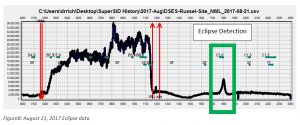Radio Astronomy
[August 23, 2017]
Deep Space Exploration Society (DSES) SuperSID station measures the August 20, 2017 Solar Eclipse!
DSES President Dr. Richard Russel has been measuring signal strengths 0f stations in the Very Low Frequency (VLF) band for the past year, looking for changes in ionospheric propagation due to solar flares. He uses a Sudden Ionospheric Disturbance (SID) monitor small radio telescope. His SID detector is located in Colorado Springs, CO. The measurements are sensitive to the changes in radio propagation at sunrise and sunset.
With his baseline of historical data at sunrise and sunset, he then predicted what could be expected during the August 20, 2017 solar eclipse. He presented his prediction work at the 2017 Society of Amateur Radio Astronomers Annual Conference at NRAO Greenbank, WV on July 25, 2017. His paper was titled, “Ionospheric Reflection Variation During Sunrise and Sunset and Predictions for the 2017 Total Eclipse”.
During the eclipse he made measurements, and found the results matched closely with his predictions. The link presents a summary of his work. Plus it has YouTube links to this and another of his talks at the SARA conference. The second talk is titled, “The Use of Monte-Carlo Analysis to Evaluate Radio Astronomy Source Detection”.

[July 27 – 30, 2017]
Ray Uberbecken presented “Using High Power FM stations to Monitor Meteor Activity Utilizing the 19-kHz Pilot Carrier” at the 2017 Central States VHF Society Conference in Albuquerque, NM. Conference (Dates: July 27 – 30, 2017). Ray’s topic is about an original engineering design and technique he developed for meteor scatter, This approach can replace using broadcast analog TV signals, most of which now are gone.
[ April 2017]
Society of Amateur Radio Astronomers Western Conference 2017 DSES Presentation and VLA Tour. Presenters: Dr. Richard Russel, President, Bill Miller, Secretary, Dave Molter, Board Member, Glenn Davis, Member:
- “Efficiency Analysis of the Plishner Radio Astronomy and Science Center Solar Power Systems”, by Bill Miller.
- “Plishner Radio Astronomy and Space Science Center 60-Foot Dish Position Indication System Development”, by David Molter, Glenn Davis, and Richard Russel.
- “The Use of Statistical Process Control to Improve the Detection of Extraterrestrial Radio Sources”, by Richard Russel.
[ December 2016]
Deep Space Exploration Society 2016 Highlights
Science Publications
Our published science papers are indexed and available on a separate page.
SETI
- Synchronized Multiple Radio Telescope Microwave SETI, HamSCI 2020, March 20, 2020. By Skip Crilly.
- Radio Search for Extraterrestrial Intelligence SETI is fun ! Geographically-spaced Synchronized Signal Detection System , by Skip Crilly, Society of Amateur Radio Astronomers conference at Greenbank, WV on August 4, 2019. This is Skip’s update of his earlier presentation below. These two wave files are part of the presentation: Figure 9 Simultaneous Tones Slow wave file and Figure 9 Simultaneous SETI Tones wave file.
- Geographically-spaced Synchronized Signal Detection System, by Skip Crilly, New Hampshire Astronomical Society, February 8, 2019. Abstract: Radio Frequency Interference (RFI) is a confounding problem in radio SETI, as false positives are introduced into receiver signals. Various methods exist to attempt to excise suspected RFI, with a possibility that true positives are rejected, and that un-excised RFI remain as false positives. Uncertain far side-lobe antenna patterns add to the uncertainty. To ameliorate the RFI problem, a system having geographically-spaced simultaneous and synchronized reception has been implemented. A radio telescope at the Green Bank Observatory in Green Bank, West Virginia has been combined with a radio telescope of the Deep Space Exploration Society, near Haswell, Colorado to implement a spatial filter having a thrice-Moon-distance transmitter rejection. Approximately 135 hours of simultaneous synchronized pulse observations have been captured from November 2017 through February 2019. This presentation describes the problem, observation system, observed results and a proposed hypothesis to be subjected to attempts at refutation through further experimentation and RFI and ETI transmitter signal model development.
- Geographically-spaced Synchronized Signal Detection System, by Skip Crilly, SARA Annual Conference – June 10-13, 2018, Greenbank Observatory, West Virginia.
- Geographically-spaced Synchronized Signal Detection System, by Skip Crilly, SARA Western Conference – March 23-25, 2018, Stanford University, Palo Alto, CA.
Historical Publications
- LARGE ANTENNA SYSTEMS FOR PROPAGATION STUDIES By Ira Kamen, Vice President General Bronze Corporation, Valley Stream, New York. Contributed by Paul Berge (K0DJV). The design criteria for our 60-foot dish antenna, from when it was constructed.
- NATIONAL BUREAU OF STANDARDS REPORT 1826
Preliminary Report on Propagation Measurements
From 92 – 1046 Mc at Cheyenne Mountain, Colorado
by G. R. Chambers, J. W. Herbstreit, and K. A. Norton. Contributed by Lauren Libby (W0LD).
Last updated March 23, 2020 (GCA)